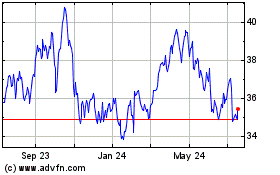By Erin Ailworth
FOWLER, Ind. -- BP PLC does big business harvesting energy in
and around this farm town. But it's not oil and gas -- it's
wind.
Hundreds of wind turbines ring Fowler, their white towers rising
for miles amid the golden-tipped cornfields and leafy soybean
plants blanketing much of Benton County, pop. 8,650. More than half
of the county's 560 turbines are operated by BP, which has three
wind farms here.
"Turbines as far as you can see," said Ryan Linzner, who manages
the BP wind farms.
Wind developers have made $17 million in payments to the county
and have spent $33 million on roads, a boon for an economically
struggling community that about a decade earlier considered hosting
a waste dump to generate jobs and government revenue.
The wind farms took hundreds of construction workers to build,
and created 110 permanent jobs, mostly wind technicians -- in
charge of servicing and maintaining wind turbines -- who, according
to federal data, earn about $51,500 a year in Indiana.
"Benton County didn't see the recession until 2011," said county
commission president Bryan Berry, who has three turbines on his
farmland. "The wind industry helped keep things open."
As wind becomes a bigger part of the U.S. electricity mix, it is
becoming an economic force in rural communities like Fowler, a
development that is changing the political conversation around
renewable energy in many parts of the country.
Wind supplied just over 6% of the country's electricity last
year, and the industry employed close to 102,000 people -- nearly
double the number working in coal mining, according to federal
data.
President Donald Trump campaigned in part on reviving the U.S.
coal industry, and has been critical of renewable-energy subsidies.
But heavily Republican states such as Indiana, Iowa, Texas and
Wyoming have embraced wind for the work and revenue it brings.
Nearly 90% of the wind capacity brought online in 2016 was in
states that voted for President Donald Trump, according to the
American Wind Energy Association, a trade group.
In the process, the industry has developed powerful allies,
including Energy Secretary Rick Perry, who presided over a
wind-turbine boom as governor of Texas, and Sen. Chuck Grassley,
the Iowa Republican who chairs the Judiciary Committee.
While some in Congress have argued against the federal subsidies
wind energy receives, Mr. Grassley said that support helped build
an industry that creates jobs and lowers the nation's need for
foreign oil.
"It helps us to be energy independent," he said, adding that
wind's growing competitiveness with traditional energy sources has
diminished the need for wind tax credits, which are being phased
out.
Excluding subsidies, it now costs about $47 per megawatt hour to
generate electricity from wind in North America over the full
lifetime of a facility, compared with $63 for natural gas and $102
for coal, according to a 2016 analysis by Lazard Ltd.
Wind now produces more than 36% of Iowa's electricity, nearly 7
gigawatts of capacity in all, second only to Texas's 21 gigawatts.
The falling price of wind power, along with its environmental
benefits, helped persuade companies like Facebook Inc., Microsoft
Corp. and Alphabet Inc.'s Google to open data centers in the state,
said Debi Durham, director of the Iowa Economic Development
Authority.
"We use this wind portfolio, this renewable portfolio, as a
calling card when we are talking to companies," she said.
Indiana is an up-and-coming wind player with nearly 2 gigawatts
of wind capacity. More than half that capacity is in Benton County,
where there is roughly one turbine for every 15 residents. Turbines
started sprouting in Benton a decade ago, a few years after a
landfill project proved unpopular in 2004.
"When renewable energy came around, it was like, well, this
isn't even close to a dump," said Benton County Economic
Development Director Paul Jackson.
In addition to BP, which owns wind farms here with Dominion
Energy Inc. and Sempra Energy, the area's wind developers include
Orion Energy Group LLC, Pattern Energy Group Inc., and the North
American subsidiary of Électricité de France SA's EDF Énergies
Nouvelles. Electricity produced by Pattern's farm is bought by
Amazon Web Services Inc., a subsidiary of Amazon.com Inc.
The wind boom has allowed Mike Kidwell, a Fowler native, to stop
commuting about 35 miles to a Subaru plant in Lafayette, Ind.,
where he worked for 18 years.
He initially found a job in Fowler as a wind technician for
Vestas Wind Systems AS, a Danish wind company, and is now vice
president of operations at Auxilius Heavy Industries, a
Fowler-based business that provides crews to service wind
farms.
"I always said if I could find something that paid good at home,
I would come back," said Mr. Kidwell, 47. Three of his six children
-- sons Nick, Brandon, and Chris -- work with him at Auxilius.
Some other counties are still debating whether wind is right for
them, concerned that the turbines are unsightly and could spook
lucrative residential development as suburbs sprawl from Lafayette
and Indianapolis. But in Benton County, they are now a fact of
life.
Farmer Bruce Buchanan, who has 14 turbines spinning amid his
corn and soybean crops, said wind payments are helping him finance
needed improvements such as fixing drainage issues.
His wife, Virginia, still hasn't gotten used to the turbines,
however, finding them unattractive and odd.
"They have them in California," she said. "I never thought of us
having them here."
Write to Erin Ailworth at Erin.Ailworth@wsj.com
(END) Dow Jones Newswires
September 06, 2017 08:14 ET (12:14 GMT)
Copyright (c) 2017 Dow Jones & Company, Inc.
BP (NYSE:BP)
Historical Stock Chart
From Mar 2024 to Apr 2024

BP (NYSE:BP)
Historical Stock Chart
From Apr 2023 to Apr 2024
